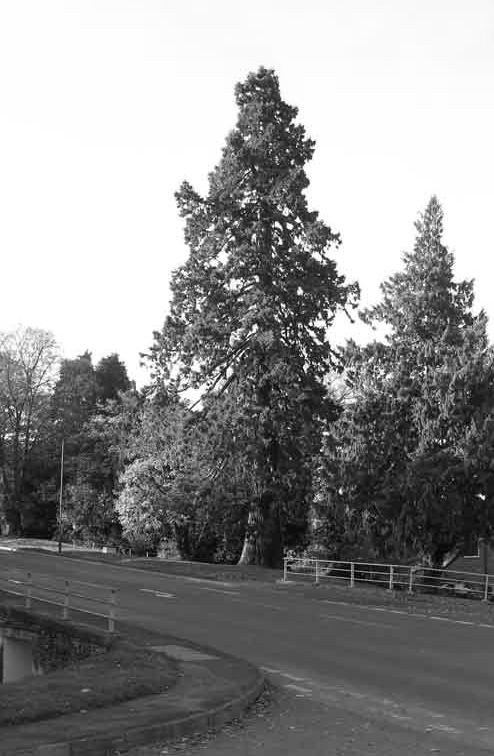By Jean Hopkinson. This article was first published in the 2011 society Journal.
A strong wind rolled dark brown ‘golf balls’ down the bank at the end of the Bromyard underpass in August and I remember resolving to find out which conifer had borne the cones. I then forgot about them until reading through a file of Phyllis Williams’s
working papers in the History Centre I came across the following invoice dated Christmas 1890 amongst others relating to Mr James Jenks’s business at the Tan Yard in Pump Street:
A.Marshall, High St., Bromyard, Green Grocer, Fruiterer, Florist etc.
1 Wellingtonia 10s 0d
1 Irish Yew 4 0
1 Cupresus 5 0
Men getting up and planting tree 1 0
2 men ¾day each, 1¼ days 4 6
1 laurel tinns 2 6
1 Cupresus Erecta 4 0
Purple beech tree 5 0
From the Ordnance Survey map surveyed in 1884 it appears that there was no garden next to the Tan House, however it does show that the present Nunwell Surgery, on the opposite side of the road, stands on a sizeable plot marked Tannery that may have
filled this role. The area, which by 1845 had already been cleared of the burgage plots developed by the bishop of Hereford in the 12th century, was an orchard and extended from the boundary with Nunwell House to include all the land at present occupied by the surgery, the width of the bypass and the ground up to the row of
cottages that stand on the west of Tower Hill. It fronted onto Pump Street, and on the west was bounded by a footpath which still stretches from Highwell Lane to the top of Little Hereford Street, passing a kissing-gate now beached forlornly at Old Ditch
Cottage. When the surgery was still in Nunwell House this land was a paddock where Dr King-Lewis kept a pony for his trap before he acquired a Daimler.

Being in the tanning business Mr Jenks would have been knowledgeable about the properties of various woods, and probably chose his purchases with care. There appear to have been six pits in the middle of the plot and maybe the intention was for the new trees to act as a screen. I determined to see if any had survived.
There is no sign of the Irish yew and a Laurelstinus might not be expected to live that long. There is, however, a pallid offspring of the purple beech, and happily spared when the bypass was put through in 1966-7 is a towering Wellingtonia only six yards from the pavement, whose cones are the origin of my ‘golf balls’ and which can remain green and hang on the tree for twenty years. Standing on council land, it is automatically protected and there is no need for one of the tree preservation orders first introduced as part of the Local Government Act of 1947. Wellingtonias were brought to Britain in 1854 and the naming of the tree after the Duke of
Wellington who had died two years previously, caused an international row between the British and the Americans who wanted it called the ‘Washington’. After years of dispute it was finally named Sequoiadendron giganteum because of its similarity to the Coast Redwood, Sequoia sempervirens.
Among other conifers are several Cupressus Lawsonia with their small spherical cones, augmented by two possible White Cedars, Thuja occidentalis, with cones that turn an attractive yellowish green as they mature; ‘by their fruits [appears to be the
only way] ye shall know them!’ I have visited the surgery since 1964 and never noticed the spectacular tulip tree by the entrance. Across the bypass in what remains of Mr Jenks’s garden is Nunwell Park carefully preserved as an open space thanks to the foresight of the then parish council and now home to Time Tower, Philip Bews’s sturdy Millennium wooden sculpture. There are also a couple of London Plane trees, but unfortunately it is impossible to say whether Mr Jenks bought these.
I have no doubt, however, that the magnificent Wellingtonia was the one planted by him, a generous benefactor during his lifetime, still ‘benefactoring’ Bromyard over a century later.
Sources
B&DLHS/AWa B56/2/8 Bills relating to Mr Jenks’ business at the Tan Yard
Roger Phillips, Trees in Britain (1983)
Ordnance Survey 1887
bbc co.uk/gardening/design – Victorian
wikipedia.org/wiki/sequioadendron
www.bewsgorvin.co.uk
